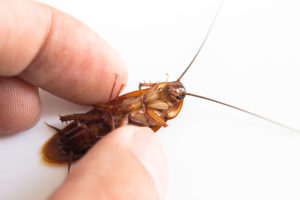 The American cockroach is also called a “waterbug”, the “Bombay canary”, and the “Palmettobug”. Despite its name, the American cockroach is not native to North America but was most probably introduced via ships from Africa. It is worldwide in distribution.
The American cockroach is also called a “waterbug”, the “Bombay canary”, and the “Palmettobug”. Despite its name, the American cockroach is not native to North America but was most probably introduced via ships from Africa. It is worldwide in distribution.
Adults about 7 3/8-2 1/8″ (34-53 mm) long. Color reddish brown except for a submarginal pale brown to yellowish band around edge of pronotal shield. Last segment of cercus at least 2 times longer than wide. Both sexes fully winged with wings of male extending beyond tip of abdomen whereas, female’s do not; poor to moderately good fliers.
The female deposits her ootheca within a few hours or up to 4 days after it is formed. It is dropped or glued with a mouth secretion to a suitable surface, usually in a crack or crevice of high relative humidity near a food source. On the average, the female will produce about 9-10 (range 6-14; maximum 90) oothecae with each containing 14-16 eggs.
Developmental time (egg to adult) is greatly influenced by temperature, varying from 168-786+ days but averaging about 600 days under ordinary room conditions. During this time, they molt 10-13 times. Adult females live about 440 days (range 102-588; maximum 913) at ordinary room conditions, but at 84°F/29°C, adult females live about 225 days (range 90-706) whereas, adult males live about 200 days (range 90-362).
Although American cockroaches are found in residences, they are much more common in larger commercial buildings such as restaurants, bakeries, grocery stores, food processing plants, hospitals, etc., where they usually infest food-storage and food-preparation areas, basements, and steam tunnels. During summer months, they can be found outdoors in yards and alleys. In the United States this is the most common species found in city sewer systems.
They can enter structures by being brought in, coming up from the sewer system via drains, or occasional mass migration from other structures, dumps, etc., during warm weather. Although they feed on many kinds of food, they show a particular fondness for fermenting food.
Follow standard control procedures but do not forget to check the drains. For sewers, power dusting with silica gel is particularly effective.
